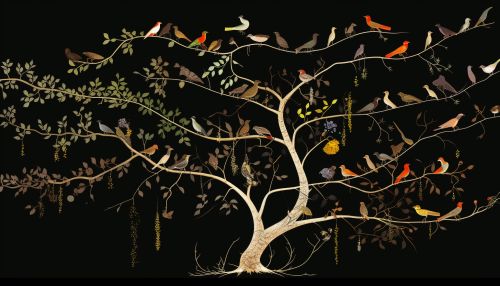Phylogenetics and Evolutionary Trees
Introduction
Phylogenetics is the study of the evolutionary history and relationships among individuals or groups of organisms. These relationships are discovered through phylogenetic inference methods that evaluate observed heritable traits, such as DNA sequences or morphology. The result of these analyses is a phylogenetic tree, a diagrammatic hypothesis about the history of the evolutionary relationships of a set of organisms.


Phylogenetic Trees
Phylogenetic trees are used to visualize the evolutionary relationships between different species. The tips of the tree represent groups of descendent taxa (often species) and the nodes on the tree represent the common ancestors of those descendants. Two descendents that split from the same node are called sister groups.
Constructing Phylogenetic Trees
Phylogenetic trees can be constructed using several different methods, each with its own set of assumptions about the process of evolution. Some of these methods include cladistics, phenetics, maximum likelihood, and Bayesian inference.
Evolutionary Relationships and Biodiversity
Phylogenetics not only helps us understand the evolutionary history of a group of organisms, but it also provides insights into the processes that have generated the vast biodiversity we see today. By studying the phylogenetic relationships among species, we can gain insights into the mechanisms of speciation, the rates of evolution, and the origins of particular adaptations.
Phylogenetics and Molecular Evolution
Phylogenetics has been revolutionized by the advent of molecular biology. The ability to sequence an organism's genome has allowed us to compare the DNA sequences of different organisms directly, providing a much more detailed and accurate picture of their evolutionary relationships.
Phylogenetics and Taxonomy
Phylogenetics has also had a profound impact on the field of taxonomy. Traditional taxonomy, which classifies organisms based on shared physical characteristics, can sometimes lead to incorrect evolutionary relationships due to convergent evolution. Phylogenetic taxonomy, on the other hand, classifies organisms based on their evolutionary relationships, providing a more accurate reflection of their evolutionary history.
Phylogenetics and Biogeography
Phylogenetics is also a powerful tool in the field of biogeography, the study of the distribution of species and ecosystems in geographic space and through geological time. By comparing the phylogenetic trees of different groups of organisms, biogeographers can infer the historical processes that have led to the current distribution of species.
